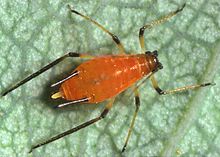Aphid
| Aphids Temporal range: Permian–present |
|
|---|---|
 |
|
| Scientific classification | |
| Kingdom: | Animalia |
| Phylum: | Arthropoda |
| Class: | Insecta |
| Order: | Hemiptera |
| Suborder: | Sternorrhyncha |
| Superfamily: |
Aphidoidea Geoffroy, 1762 |
| External identifiers for Aphidoidea | |
|---|---|
| Encyclopedia of Life | 551 |
| ITIS | 109190 |
| NCBI | 33385 |
| Also found in: , ToLWeb | |
Aphids, also known as plant lice and in Britain and the Commonwealth as greenflies, blackflies, or whiteflies (not to be confused with "jumping plant lice" or true whiteflies), are small sap-sucking insects, and members of the superfamily Aphidoidea. Many species are green but other commonly occurring species may be white and wooly, brown, or black. Aphids are among the most destructive insect pests on cultivated plants in temperate regions. They are capable of extremely rapid increase in numbers by asexual reproduction. The damage they do to plants has made them enemies of farmers and gardeners around the world. From a zoological standpoint they are a highly successful group of organisms.
About 4,400 species are known, all included in the family Aphididae. Around 250 species are serious pests for agriculture and forestry as well as an annoyance for gardeners. They vary in length from 1 to 10 millimetres (0.04 to 0.39 in).
Natural enemies include predatory ladybugs, hoverfly larvae, parasitic wasps, aphid midge larvae, crab spiders, lacewings, and entomopathogenic fungi such as Lecanicillium lecanii and the Entomophthorales.
Aphids are distributed worldwide, but are most common in temperate zones. In contrast to many taxa, aphid species diversity is much lower in the tropics than in the temperate zones. They can migrate great distances, mainly through passive dispersal by riding on winds. For example, the currant-lettuce aphid, Nasonovia ribisnigri, is believed to have spread from New Zealand to Tasmania in this way. Aphids have also been spread by human transportation of infested plant materials.
...
Wikipedia
